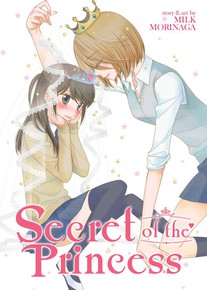Review
by Rebecca Silverman,Secret of the Princess
GN
| Synopsis: |  |
||
All her life, Miu's mother has told her that girls have to be pretty to attract their prince. Miu's taken this to heart, but after reaching high school, she's yet to meet her perfect boy. Then one day, she witnesses her classmate Fujiwara accidentally break the principal's expensive vase. The other girl begs her not to tell, saying she'll do anything. Since Miu figures she could use the practice, she asks Fujiwara to pretend-date her so that she'll know what to do when she finds her man. But what if “pretend” isn't actually what she wants? Could Miu's prince actually be a princess? |
|||
| Review: | |||
If someone tells you something long enough, it's hard not to believe it. Usually this line is brought out to explain low self-esteem or an inability to try something new, but in Secret of the Princess, yuri mangaka Milk Morinaga uses it to help her heroine question the heteronormativity that her mother's been parroting her entire life. Miu's mother has always told her daughter “Since you're a girl, you have to be cute all the time. As long as you stay cute, you'll snag a great guy!” Now in her first year of high school, Miu has become obsessed her hair, makeup, and clothes being as perfect as possible, so she'll be the absolute cutest she can be. She does all of this in order to get the mysterious “great guy” her mother's always drilled into her as the ultimate desire of all girls. The “happiness = marriage to a man” equation that she's been taught seems unshakable at first. Enter Fujiwara. She's a year ahead of Miu at their all-girls' school, a star on the volleyball team, and the apple of all the other students' eyes. Miu has always come to school early to watch her practice, but she wrote it off as a need to look perfect before classes begin, so when she finds Fujiwara having just broken the principal's expensive vase, she doesn't quite know what to do. Fujiwara says that she'll do anything for Miu as long as she doesn't tell, and before Miu quite knows what she's saying, she's asking Fujiwara out. She quickly backtracks that she just wants to practice for when she finds a boy, and Fujiwara takes her at her word, but as readers, we have to wonder. Morinaga is familiar enough with the conventions of yuri romance manga that she can use them for her own ends, as Miu tries to work out her feelings. From the justification of “it's not real because we're both girls” to the mean girl phenomenon coupled with other girls thinking it's gross that two females are dating, Morinaga whips out all of the old saws, right down to Fujiwara showing up to their first date dressed like a boy. All of this is ultimately in service of Miu recognizing that the things she's always taken as rules are just expectations, and that perhaps she doesn't actually want what she's been told she should want. That's the strongest aspect of this slim volume. Miu's so trapped in what she's been told that she can't recognize her own emotions, while Fujiwara is simply clumsy with her feelings and trying to figure out how best to make things work. Other classmates also help to highlight that there's something more genuine about Miu and Fujiwara's relationship, as does the artificiality of how both girls try dressing to impress each other. Miu's too-cute hairstyle and Goth Loli outfits make her look like she's trying to be someone she's not; the same goes for when Fujiwara cuts her hair in an effort to look more like a foreign prince for her girlfriend. Even though the girls are in love with each other as people on the inside, they can't separate from the idea that somehow appearances are all-important. Morinaga makes this clear at the end of the book, when we see the girls a year later – both look much more comfortable dressed as themselves, not just with each other, but with who they really are. The romance itself is in Morinaga's usual sweet vein. While there are sexual implications at the volume's end, most of this story is about the emotional rather than the physical component of love. In this case, it doesn't feel like an attempt to make girls' love somehow more “pure,” but rather goes hand-in-hand with Miu's inner conflict as she tries to sort out what she really wants. The physical aspect doesn't go beyond hand-holding until both girls are ready to acknowledge that they want a real relationship, and that works nicely with the themes of the story. If you're already a fan of Morinaga's other works, like Girl Friends or Kisses, Sighs, and Cherry Blossom Pink, you know you're going to like this book. But if you've never read any yuri and find yourself curious, this makes for a very sweet and reassuring introduction to the genre. With its attention to the conflicts Miu and Fujiwara are facing (although we don't have much from Fujiwara's point of view) and interesting use of genre tropes, Secret of the Princess is a charming love story that reminds us that what we've been told isn't always the truth. |
| Grade: | |||
|
Overall : A-
Story : A-
Art : B
+ Story gives attention to both internal and external conflicts, Miu's growth is enjoyable to watch, included short story is cute |
|||
| discuss this in the forum (2 posts) | | |||
| Production Info: | ||
|
Full encyclopedia details about Release information about |
||